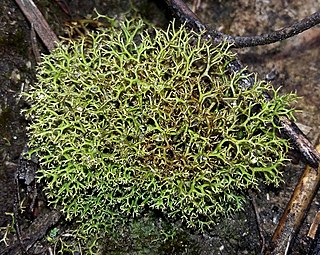
The Cladoniaceae are a family of lichen-forming fungi in the order Lecanorales. It is one of the largest families of lichen-forming fungi, with about 560 species distributed amongst 17 genera. The reindeer moss and cup lichens (Cladonia) belong to this family. The latter genus, which comprises about 500 species, forms a major part of the diet of large mammals in taiga and tundra ecosystems. Many Cladoniaceae lichens grow on soil, but others can use decaying wood, tree trunks, and, in a few instances, rocks as their substrate. They grow in places with high humidity, and cannot tolerate aridity.

Bacidia is a genus of lichen-forming fungi in the family Ramalinaceae. The genus was circumscribed by Giuseppe De Notaris in 1846.
Notocladonia is a genus of two Australasian species of lichenized fungi in the family Cladoniaceae. The genus was circumscribed by lichenologist Samuel Hammer in 2003. The type species, Notocladonia cochleata, was previously placed in the genus Ramalea.

Cladia is a genus of lichen-forming fungi in the family Cladoniaceae. Cladia species have a crustose or squamulose (scaly) primary thallus and a fruticose, secondary thallus, often referred to as pseudopodetium. The type species of the genus, Cladia aggregata, is widely distributed, occurring in South America, South Africa, Australasia and South-East Asia to southern Japan and India. Most of the other species are found in the Southern Hemisphere.

Pannaria is a genus of lichen-forming fungi in the family Pannariaceae. The widespread genus contains an estimated 51 species, found primarily in tropical regions.
Tremotylium is a genus of lichen-forming fungi in the family Graphidaceae. The genus was circumscribed by Finnish lichenologist William Nylander in 1865, but it was not published validly. He validated the genus and assigned T. angolense as the type species in 1868.
Badimia is a genus of foliicolous (leaf-inhabiting) lichens in the family Ramalinaceae.
Sporopodium is a genus of lichen-forming fungi in the family Pilocarpaceae.

Mazosia is a genus of lichen-forming fungi in the family Roccellaceae. The genus was circumscribed by Italian lichenologist Abramo Bartolommeo Massalongo in 1854.

Anisomeridium is a genus of lichens in the family Monoblastiaceae. The type species was originally named Arthopyrenia xylogena by Swiss botanist Johannes Müller Argoviensis in 1883; in 1928, Maurice Choisy defined the genus Anisomeridium, designating A. xylogena the type species.

Hypogymnia is a genus of foliose lichens in the family Parmeliaceae. They are commonly known as tube lichens, bone lichens, or pillow lichens. Most species lack rhizines that are otherwise common in members of the Parmeliaceae, and have swollen lobes that are usually hollow. Other common characteristics are relatively small spores and the presence of physodic acid and related lichen products. The lichens usually grow on the bark and wood of coniferous trees.
Gyalectidium is a genus of lichen-forming fungi in the family Gomphillaceae. A 2020 estimates placed 52 species in the genus. The genus was circumscribed by Swiss lichenologist Johannes Müller Argoviensis in 1881. He included 3 species: G. xantholeucum, G. dispersum, and G. filicinum; the last of these is now the type species of the genus.

Tricharia is a genus of lichens in the family Gomphillaceae. It has an estimated 30 species.
Pseudopyrenula is a genus of lichen-forming fungi in the family Trypetheliaceae.

Phlyctis is a genus of lichenized fungi in the order Gyalectales, and the type genus of the family Phlyctidaceae. Members of the genus are commonly called blemished lichens.

Thelenella is a genus of lichen-forming fungi in the family Thelenellaceae. It has 30 species. The genus was circumscribed by Finnish lichenologist William Nylander in 1855, with Thelenella modesta assigned as the type species.
Pyrenidium is a genus of lichenicolous (lichen-dwelling) fungi. It is the only genus in the family Pyrenidiaceae. It has 13 species.
Strangospora is a genus of lichen-forming fungi. It is the only genus in the family Strangosporaceae, which itself is of uncertain taxonomic placement in the Ascomycota. It contains 10 species.









